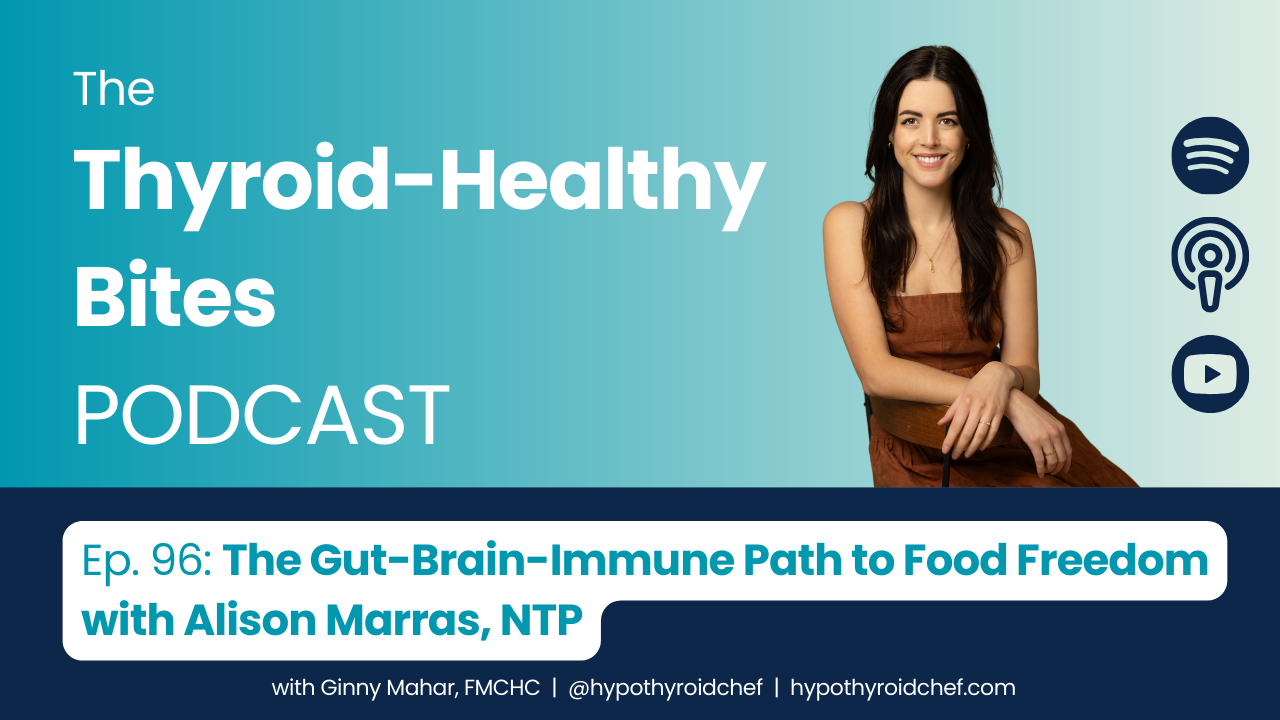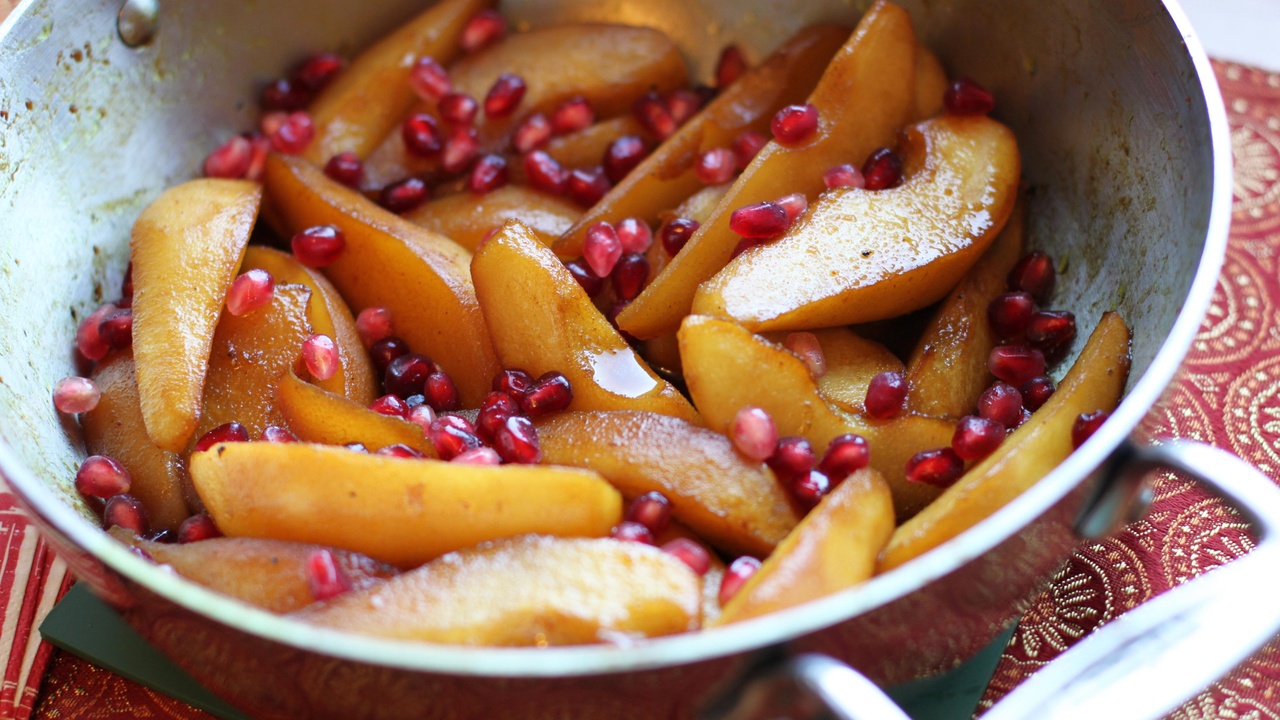Red Lentil Rainbow Soup
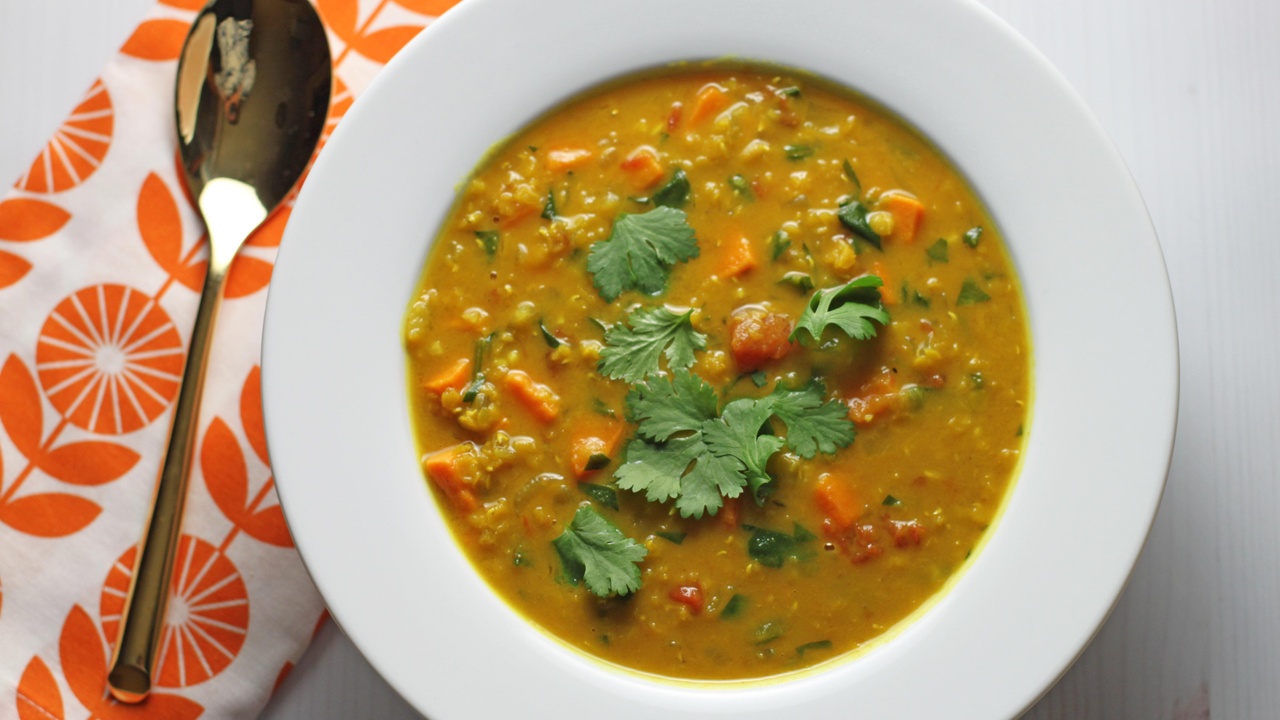
Warming spices mingle with high-fiber lentils, comforting cubes of sweet potato, wilted greens, and gut-nourishing bone broth in this colorful bowl. This Red Lentil Rainbow Soup combines humble ingredients and turns them into a feast of color, flavor, and nutrients.
This recipe also happens to be gluten and dairy-free and is also vegan-friendly (see recipe notes for instructions).
One of the most effective, simple, and fun ways to increase the nutrient density of our meals is to add more color to our cooking. In other words, you can uplevel your diet by eating a colorful rainbow of whole foods (and no, that doesn't mean Skittles).
In addition to being easy to make, this soup features an incredible amount of colors and nutrients, including key thyroid-supportive ones like protein, fiber, zinc, magnesium, vitamin A, B vitamins, and a "rainbow" of other anti-oxidants and polyphenols. Just to put this over the nutritional top, the warming aromatic spices like ginger, turmeric, coriander, and garlic are anti-inflammatory and can support our built-in detoxification pathways.
Make a big batch of this Red Lentil Rainbow Soup on the weekend, and you'll have a heat-and-eat nutrient-dense meal ready to go all week! This recipe also freezes beautifully for up to 2 months.
Full disclosure: Some of the links in this post may be affiliate links. As an Amazon Associate, I earn from qualifying purchases. Purchasing a product using one of these links will support my work at no additional cost to you. Please know that I only recommend products I wholeheartedly stand by.
Nutritional Highlights of Lentils
For those of us who can tolerate them, lentils are absolutely packed with nutrition.
A 1-cup serving of cooked lentils contains these beneficial nutrients:
- 17.9 grams of (incomplete) protein
- 15.6 grams of fiber
- 28% DV of Thiamine
- 13% DV of Niacin
- 21% DV of B6
- 37% DV of Iron
- 17% DV of Magnesium
- 16% DV of Potassium
- 23% DV of Zinc
All this nutrition (and much more) for the low caloric cost of 230 calories per serving-- not to mention the low monetary cost of this affordable, shelf-stable legume.
The nutrients listed above have specific benefits for thyroid health and/or those with hypothyroidism or Hashimoto's. For example:
- Fiber: The very high fiber content of legumes, for example, can help us Thyroid Thrivers with three of our most textbook hypothyroid symptoms: constipation, gut health issues, and weight gain.
- Zinc is required for thyroid hormone synthesis, and zinc deficiency can lead to hypothyroidism.
- Protein supports our thyroid function and overall hormonal health.
Lentils are also high in polyphenols, or plant-based compounds that provide anti-oxidant and anti-inflammatory properties. While lentils do contain some antinutrients (more on that below), cooking and/or soaking them greatly reduces the presence of these anti-nutrients.
Further Reading: Myths, Fears & Roadblocks Around Thyroid Healthy Eating
Why Lentils are Not Considered Paleo or AIP-friendly
Lentils are an affordable and quick-cooking source of plant-based protein, fiber, and beneficial nutrients. However, many therapeutic, gut-healing diets like the Autoimmune Protocol, Whole30, and the Paleo diet do not allow lentils during the elimination phase. Let's talk about why.
The reason for this, according to experts like Dr. Sarah Ballantyne, is that legumes, which include lentils, peas, beans, and peanuts, can be hard on the gut. They have the potential to aggravate and damage the intestinal lining and be hard to digest. For someone who is actively trying to heal their gut or dealing with gut issues, which includes many of us Thyroid Thrivers, it may make sense to eliminate legumes, including lentils, temporarily to facilitate healing.
Legumes contain naturally-occurring toxins commonly referred to as anti-nutrients, including lectins and phytates. The presence of lectins and phytates has given legumes a bad rep because they are purported to block the absorption of nutrients, inhibit digestive enzymes, and damage our intestinal lining.
While that sounds bad, it's important to note here that many highly-nutritious plant foods contain naturally-occurring toxins, and we should exercise caution when blacklisting nutritious foods. Zeroing in on one problematic aspect of a certain food is often taken out of context of the big nutritional picture of that food.
If you get right down to it, you could come up with reasons NOT to eat just about any food, including many legitimately healthy ones. An overabundance of food fear, which can lead to disordered eating (such as orthorexia), is a pitfall we want to avoid on the healing journey.
The legume debate is a hot one, with lots of conflicting research and opinions on the subject. Chris Kresser, for example, made big waves in the Paleo community by suggesting on the Dr. Oz show that eating a few servings of legumes a week was fine if you tolerate them, which goes against what he calls "Paleo dogma," or a set of beliefs accepted by the members of a group without being questioned or doubted.
Kresser points out that many other healthy foods that are allowed on diets like Paleo, Whole30, and AIP also contain lectins and phytates. A few of these foods include carrots, zucchini, cherries, garlic, walnuts, mushrooms, spinach, and chard-- no nutritional slouches! Additionally, some of these foods contain anti-nutrients in much higher amounts than legumes.
While the term anti-nutrients does a pretty effective job of villainizing legumes, like lentils, it's important to note the importance of context. Cooking legumes, for example, inactivates lectins-- a rather important detail that was neglected in many of the studies used to back the anti-legume argument. Also, the presence of simple carbohydrates, like those found in legumes, can help neutralize their anti-nutrients, as can soaking the legumes before consumption.
Like so many nutritional choices, there are complexities that must be taken into account, including the bio-individual needs and sensitivities of the person consuming the food.
The takeaway: If you are on a strict gut healing protocol, or or are dealing with gut health issues, legumes may cause more GI stress and strain than is ideal for you. However, many of us who have done some gut healing may tolerate lentils well. Others still, may have a relatively healthy gut, but be particularly sensitive to the GI distress that legumes can cause. It all comes down to your individual needs, sensitivities, and health circumstances.
Are lentils and legumes right for you? This is where I'll circle back around to Kresser's words about legumes: a few servings a week is fine if you tolerate them. If legumes aren't right for you at this time, skip this recipe and choose from several other Paleo and AIP-compliant soups in my recipe library.
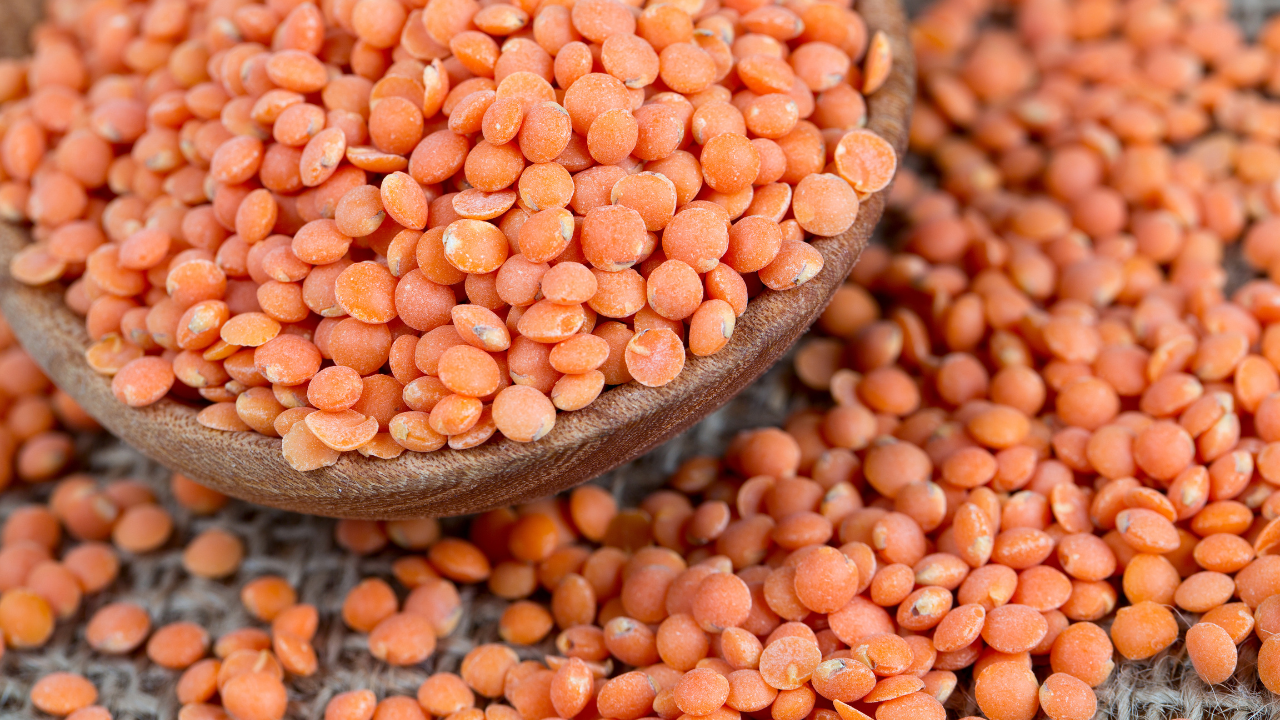
Lentils: A Less Problematic Legume
In comparison to most other kinds of beans, lentils, in particular, are lower in so-called anti-nutrients.
Looking at the antinutrient phytic acid, for example, lentils contain 270 - 1,500 mg of phytic acid per 100 grams, while most other beans contain between 500 and 2,900 mg per 100 grams. To put that in perspective, spinach contains 3,670 mg of phytic acid per 100 grams.
This difference between lentils and other beans (like pinto, black, navy, or kidney) has inspired some updated nutritional guidelines in the therapeutic nutrition world. In fact, in 2019, the official reintroduction phases of the AIP (Autoimmune Protocol) were updated to allow the reintroduction of peas, lentils, and garbanzo beans sooner in the reintroduction process.
According to Autoimmune Wellness: Peas, lentils and garbanzo beans are especially beneficial for the gut microbiome while containing lower amounts of antinutrients and agglutinins that are more easily deactivated by heat than other legumes like kidney beans, soy, and peanuts. For this reason, it seemed prudent to separate them from other legumes and encourage reintroduction earlier than previously.
While this update does not mean you should go ahead and eat lentils during the strict elimination phase of the AIP, it does mean that this soup may be a delicious, nutritious, and health-supportive option for you in Reintroduction Stage 3. (Formerly, lentils were a Stage 4 reintroduction.)
While they may be too hard on a severely compromised or leaky gut for some, for those who tolerate them, lentils have many benefits for our gut health and microbiome.
According to Paleo Mom: Lentils increase abundance of probiotic strains of Actinobacteria and Bacteroidetes, while increasing resistance to pathogen colonization in the gut. The microbiome changes resulting from high lentil consumption are also associated with leanness and lower cardiovascular disease risk factors.
There is so much good in lentils. I hope this information has empowered you to make the best food choices for your personal needs. And if you've been avoiding lentils because you read that legumes are "bad for you," I hope this information has made you think twice.
If you're still on the fence, here's an incredibly long list of other health benefits of this Red Lentil Rainbow Soup...
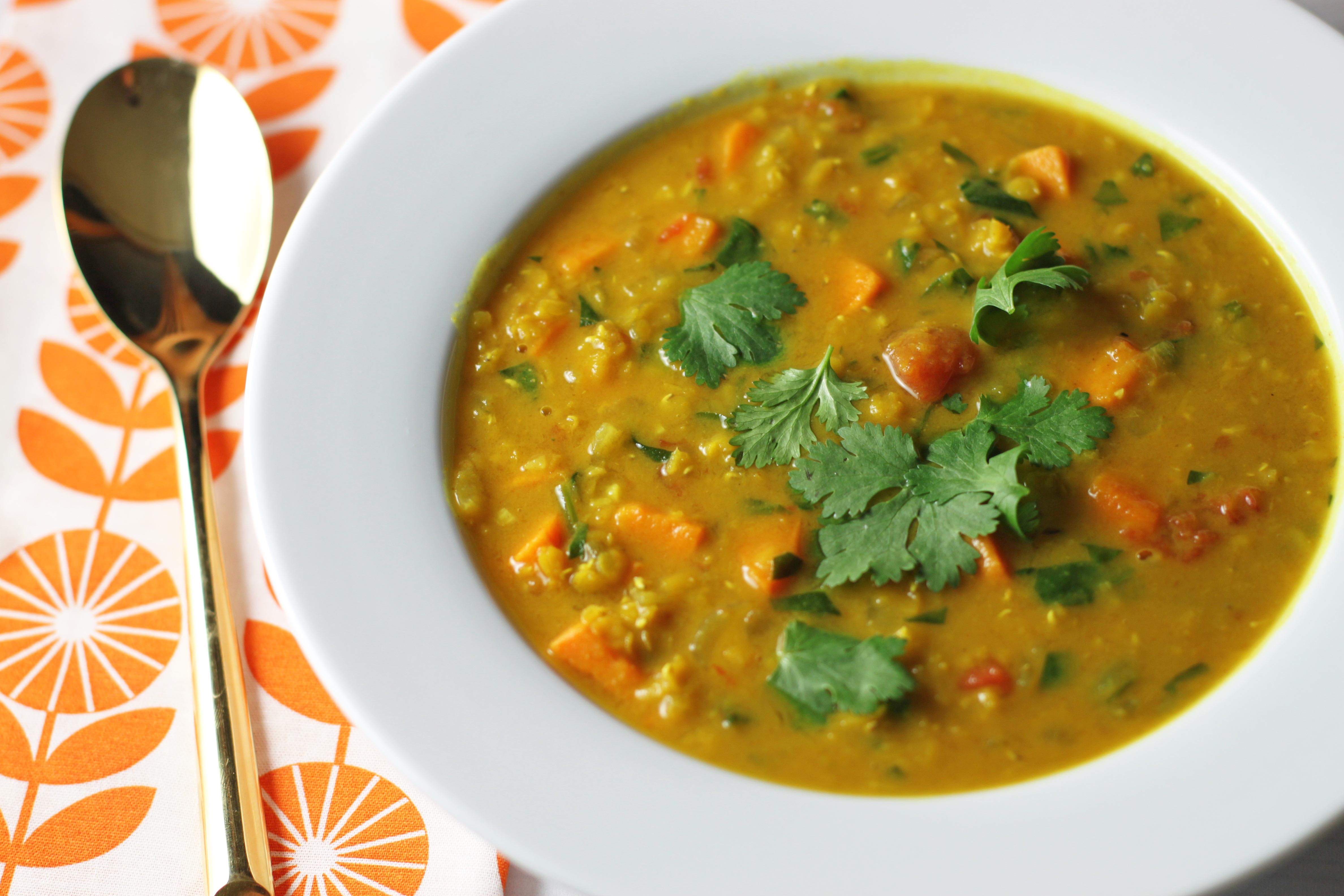
Thyroid-healthy Recipe Highlights:
- Lentils are incredibly high in plant-based protein and fiber, boasting 17.9 grams of (incomplete) protein, and 15.6 grams of fiber per 1 cup serving. Lentils can support digestion, weight loss, cardiovascular health, gut health, and a healthy microbiome. Lentils are also high in several thyroid-supporting micronutrients like B vitamins, zinc, potassium, iron and magnesium.
- Cilantro: Studies have shown that cilantro can help accelerate the body’s excretion of mercury and lead. Heavy metal toxicity from mercury has been linked to an increase in thyroid antibodies.
- Coconut Milk: Coconut products such as coconut milk contain a wide array of vitamins and minerals, in addition to healthy fats known as MCTs (medium-chain triglycerides) or MCFAs (medium-chain fatty acids). Consumption of these fats has been touted for various health benefits such as brain health, weight loss, and cholesterol balance. Coconut can also be a positive dietary substitution for refined carbs and sugar, which can diminish thyroid and overall health.
- Bone broth is one of the most highly recommended foods for anyone suffering from an autoimmune disease like Hashimoto’s. The collagen and glycine can help repair cell damage in the intestinal tract.
- Sweet potatoes are loaded with complex carbohydrates that can help fill you up and stabilize blood sugar levels. They’re also a rich source of thyroid- and immune-supportive antioxidants beta carotene and vitamin C, as well as the minerals copper and manganese. In addition, sweet potatoes support gut health with prebiotic fiber and are also considered anti-inflammatory.
- Turmeric has multiple health benefits for those of us with thyroid disease. It can help protect and heal the intestinal barrier (leaky gut), and reduce inflammation throughout the body, in joints, muscle tissue, and even from GI conditions like Crohn’s, IBS, and ulcerative colitis.
- Dark Green Leafy Vegetables or "DGLVs," including spinach, are one of the most highly-recommended foods to eat more of by nutritionists from all schools. In addition to being high in fiber, low in calories, and extremely nutrient-dense, they feature several key thyroid-supporting nutrients, such as Vitamins A, C, and B vitamins, as well as magnesium, potassium, and iron. While some greens, especially those in the brassica family like kale and collards, have been purported to slow thyroid function when eaten raw and in large amounts, any goitrogenic (thyroid-inhibiting) properties are greatly reduced by simply cooking the greens.
- Garlic has many powerful healing properties, which can aid or alleviate some of the symptoms of thyroid conditions, such as inflammation, cardiovascular issues, decreased immunity, and increased infection. It can also support the liver in its detoxification efforts.
- Ginger aids in relieving both the inflammation and the sensitivity to cold sometimes caused by thyroid disease.
Happy cooking, happy thriving, and enjoy the recipe!

P.S. If you're anything like me, when I started down the path of thyroid-healthy eating I had questions-- lots of them. What I didn't have was a step-by-step system, to get me where I wanted to go. I wasted a lot of time piecing together bits of information about what to eat, what to avoid, and HOW to make thyroid-healthy dietary changes. That’s why I created the Thyroid-healthy Meal Plan Kickstart. Ready to take YOUR healing journey farther, FASTER? Let’s do it. Learn more HERE.
More Thyroid-healthy Soup Recipes:
- Chilled Avocado Soup
- Italian Sausage Minestrone
- Turkey Albondigas Soup
- Hoppin' John Soup
- Creamy Carrot Coconut Soup
- Zucchini Basil Breakfast Soup
- Thai Chicken Soup
- Split Pea Soup with Smoked Ham
- Tomato, Sausage, and Fennel Soup
- Lamb Stew with Mushrooms and Red Wine
Subscribe to my free newsletter for fresh recipes & lifestyle tips, delivered weekly, and receive a free gift!
By submitting this form, you agree to receive ongoing updates from Hypothyroid Chef





